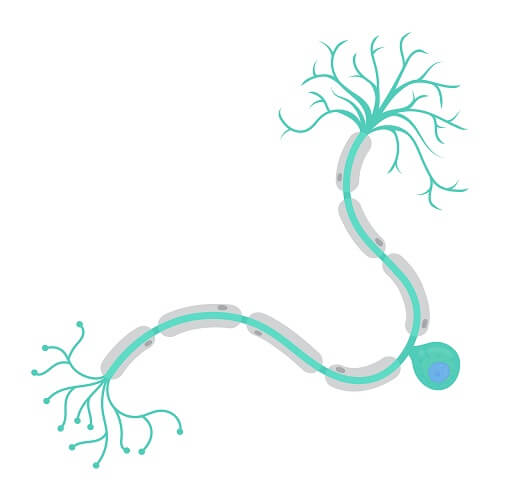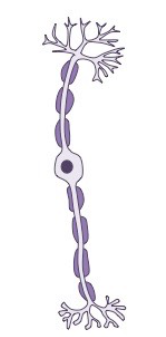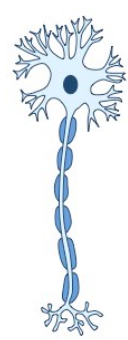Biopsychology: Neurons and Synaptic Transmission
1/11
There's no tags or description
Looks like no tags are added yet.
Name | Mastery | Learn | Test | Matching | Spaced |
|---|
No study sessions yet.
12 Terms
Nervous system- Micro level
contains about 100 billion nerve cells called neurons (80% located in brain alone)
cells that relay information around the brain and nervous system by using electrical impulses and chemicals called neurotransmitters
Electrical impulses travel from one end of a neuron to another and release a chemical known as a neurotransmitter
if they aren’t working this will affect our behaviour in multiple ways
Structure of a neuron
dendrite
nucleus
axon
myelin sheath
nodes of Ranvier
terminal buttons

Sensory neuron (unipolar)
carry messages from the PNS to the CNS
they only transmit messages and hence is unipolar
tell the brain about the external & internal environment by processing info from 1 of 5 sets of sensory receptors which is converted into neural impulses
in the brain these impulses are translated into sensations we can appropriately react
have long dendrites and short axons

relay neuron (multipolar)
most common type of neuron in the CNS
allow sensory and motor neurons to communicate and connect with each other (carry nerve impulses between neurons)
they are multipolar as they send and receive info from many sources
aren’t found in other parts of the nervous system as they only carry messages from one part of the CNS to the other (just brain, spinal cord and visual system)
have short and stubby dendrites and axons

Motor neuron (multipolar)
connect the CNS to effectors such as muscles and glands
multipolar as they send and receive info from many sources
project their axons outside the CNS to directly or indirectly control muscles and glands
form synapses with muscles and when stimulated release neurotransmitters to trigger a response in the muscle (contracts)
strength of these contractions depends on the rate of the nerve impulses (inhibitors can cause muscle relaxation)
short dendrites and long axons
Synaptic transmission (part 1)
when the dendrite picks up the message it sends an impulse through the cell body and along the axon to the terminal buttons
Synaptic transmission (part 2)
once the action potential has arrived at the terminal buttons at the end of the axon it needs to be transferred to another neuron
to achieve this it must cross the synaptic gap
Synaptic transmission (part 3)
at the end of the terminal buttons are the synaptic vesicles that contain and store neurotransmitters
these NT’s are chemical messengers that convert the impulse to a chemical message that’s transferred to the next neuron
Synaptic transmission (part 4)
as the impulse travelling to the end of the neuron reaches the synaptic vesicle they release the NT then crossing the synaptic gap
Synaptic transmission (part 5)
as the NT diffuses across the synapse it binds to specialized receptors on the surface of the next cell (on it’s dendrites) that recognise it and match that particular cell
Synaptic transmission (part 6)
once the next cell is activated the receptor molecules produce either an excitatory effect (strengthens; adrenaline) or inhibitory effect (weakens; serotonin) at a post synaptic level
Synaptic transmission (part 7)
synaptic transmission is completed by a process called reuptake, this is where NT is taken back up/ recycled by the pre synaptic neuron
enzymes break down remaining left in the synapse